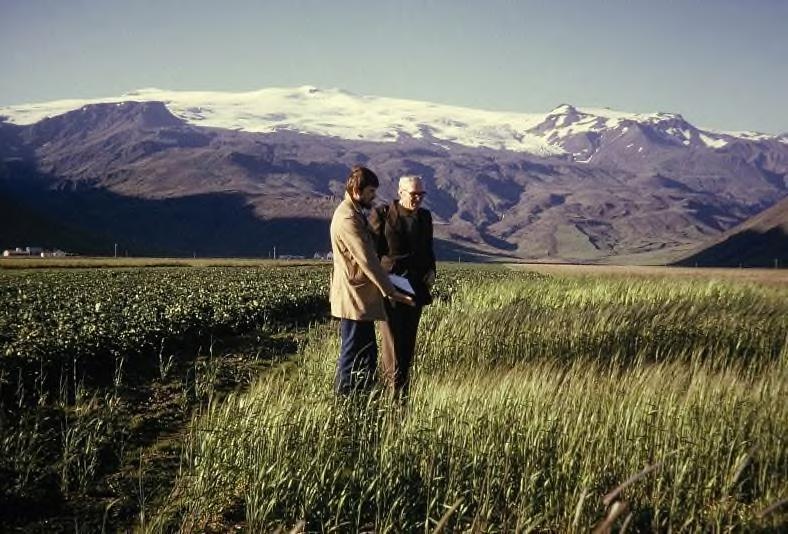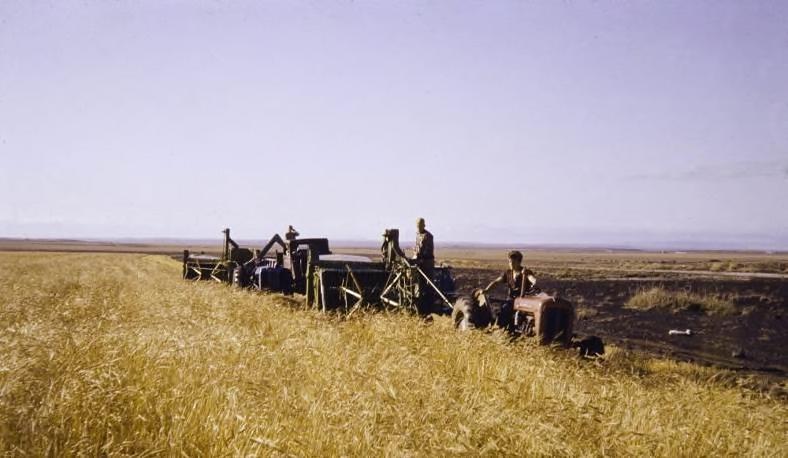
5 minute read
End of the brief renaissance
We got out and sensed the ice-cold orkan being whipped up. We had great difficulty loading the car, but headed through the very cold and violent storm for the nearest farm where we stayed overnight. The morning after the temperature had dropped from +8°C to -17°C and the wind had blown away all the plantings from March and ruined a large part of the plantings we had just made, not to speak of the tent and supplies. This storm is still referred to as the storm that killed most of the poplar trees and Sitka spruces in Iceland, and also took the lives of a number of fishermen. The May sowing was carried out without incident. The yields of the surviving plants were poor or ranging from 0.12 to 1.45 t ha-1. A detailed account of other experiments from 1963 can be found in Appendix.
In the fall of 1963, the author followed the migrant birds and moved from Iceland to warmer climes first on temporary leave so that he was in nominal charge of the grain experimental activities for the following two years. Jónas Jónsson took over the supervision of the research activities on grain and carried them out until they were terminated. The research activities in the following years were more or less along the same lines as described above. Emphasis was put on finding suitable introduced varieties and continuing the breeding programme through further selection and propagating promising breeding lines. Farmers and agricultural advisers were still interested in doing local trials and observations. In the years 1962 and 1963 the climatic conditions had become progressively worse but 1964 turned out to be still worse as reported in the letter from Klemenz Kr. Kristjánsson cited above. It is interesting to note that in his letter he reports that in this cold summer of 1964, the radiation- mutant, the 2-row barley variety Mari, bred by Prof. Åke Gustafsson of Svalöf, Sweden, yielded 3.5 t ha-1 and a line of Dönnes barley yielded 3.2 t ha-1 at Sámsstaðir. Winter barley, seeded on 15 July 1963 and harvested fully ripe on 10 August 1964 yielded 3.5 t ha-1. Klemenz was still doubtful about the suitability of winter barley for Iceland as it can only be harvested every second year due to the need for seeding in mid-summer the previous year. In 1964 Klemenz gave a short summary of his experience with grain growing in Iceland over the years where he states that at Sámsstaðir in 1928 – 1940, the barley varieties Dönnes, Maskin and Jøtun yielded on the average 1.82 t ha-1. In 1961 the mean yield was 1.56 t ha-1. The yield of oats, Nidar, Voll and Orion in 1928 – 1939 averaged at 2.3 t ha-1 while hay yields averaged at 4.53 t ha-1. Turnip yields in 1932 to 1936 averaged over 30 t ha-1 and potatoes 2332 t ha-1 .
The agricultural adviser in east Iceland, Páll Sigbjörnsson, wrote a summary of the 1963 experience: „Barley was seeded at 27 locations in east Iceland. The varieties used were the 6-row varieties Fløya and Sigur, and the 2-row varieties Union, Mari and Herta. The planting time was the latter half of May. In general the plants developed well into the summer. In September many farmers gave up all hope of getting a fully mature grain harvest and started to cut the fields for green fodder. Grain harvest started in mid-September with yields from 1.2 to 1.5 t ha-1, and the grains were reasonably well mature. The main harvest started at the end of September and harvesting of the 6-row varieties was completed in mid-October. Many of the 2-row varieties were harvested later. The harvest was poor everywhere. The 6-row varieties yielded 1-1.2 t ha-1 and the 2-row varieties yielded 0.7-1.0 t ha-1. All the 2-row varieties matured later than the 6-row varieties. The old hardy Faroe Islands variety Sigur did not ripen at all and was not harvested. Most of the varieties survived the severe frosts, especially the 2-row varieties although damaged. The spikes of some varieties reached full size but had no grains, probably due to frost damage during pollination.“ Then Páll states: „The previous two
Figure 16. Trial with barley lines and fertilizer rates on Skogasandur 1962.
Figure 17. Prof. Sigurdur Helgason, University of Manitoba with Thorsteinn Tomasson at Thorvaldseyri 1985. summers have dampened the enthusiasm in farmers who are nevertheless still expected to continue on the same scale in 1964“.

In 1963-64 the author assisted in ordering barley and oat seeds from 27 seed firms and research institutes in the UK, Norway, Sweden, Finland, the Netherlands, Ontario and Manitoba, Canada and from Minnesota, U.S.A. In 1965 the trials were carried out nearly on the same scale as in 1964. On a visit to Iceland in 1966 the author visited some of the 21 cereal experiments carried out that year. Local trials were mostly carried out on the same farms and experimental stations as before, mostly barley, but also some oats. There were five large scale experiments at Gunnarsholt and three at Korpa. There is no mention of any activities at Skógasandur that year. The author has not been able to locate details for these activities, nor any reports on results.
In 1964, 1965 and 1966 Jónas Jónasson followed up on the breeding activities to the extent possible under the deteriorating growing conditions. In 1964 there was some material in the F2 generation from which he made selections, establishing F3 lines as spike progenies in 1965 both from the crossed material and from the progeny of the radiation-treated populations received from Canada and the composite crosses from California. The last were rather disappointing with very few interesting lines. These breeding lines were evaluated for date of emergence, height, straw strength and shattering resistance. Jónas had plans to establish progeny lines from each spike line in 1966 and make selections from these progenies. He then planned further hybridizations between the best selections in a rented greenhouse space. However, all this effort came to nothing after even all the reserve seed had been sown and then failed to give viable seeds due to the poor climatic conditions. Thus the brief grain growing renaissance starting in 1960 came to a much premature end due to the outset of the „little ice age“.







